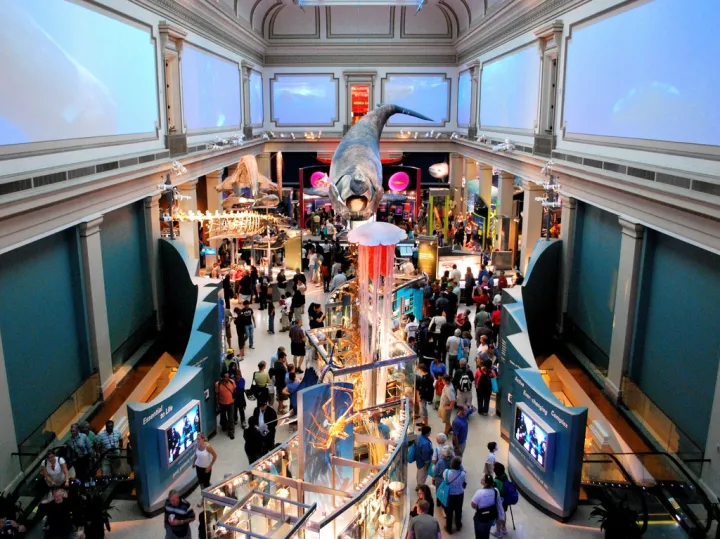Sant Ocean Hall
A Look Inside the Sant Ocean Hall
The Sant Ocean Hall is the National Museum of Natural History's largest exhibit, providing visitors with a unique and breathtaking introduction to the majesty of the ocean. The hall's combination of 674 marine specimens and models, high-definition video, and the newest technology allows visitors to explore the ocean's past, present, and future.
If you are coming to Washington, D.C., start planning your visit now to the National Museum of Natural History and Sant Ocean Hall.
HOURS: Open daily except December 25, 10:00 AM - 5:30 PM. For extended Museum hours, visit the National Museum of Natural History website.
FREE ADMISSION: Admission is free to the museum and programs, except where noted.
LOCATION: For the Museum's location, visit the National Museum of Natural History website.
Visitors entering the 23,000-square-foot exhibition will see a precise replica of a 45-foot-long North Atlantic Right Whale, named Phoenix, who has been tracked by scientists since her birth in 1987, and a giant squid — so rarely seen that a living squid was not caught on camera until 2004. A unique underwater experience is created by "Ocean Odyssey," a high-definition film by renowned underwater cinematographer Feodor Pitcairn, which wraps the walls above the exhibit space. And, like the real ocean, the deeper visitors explore the more they will discover — from the sunlit surface to the dark, pitch-black ocean depths, from the smallest microorganism to the biggest animals ever known—featuring items from the museum's marine collections.
There is also an ever-changing exhibit space in the back of the hall. Currently featured is the "Life in One Cubic Foot" exhibit, an interactive exhibit that explores what we can discover in just a cubic foot of Earth. You can witness the ocean’s constant motion and interaction with land and the atmosphere through data and imaging on the state-of-the-art exhibit Science on a Sphere, created by the National Oceanic and Atmospheric Administration.
Here are some of the art and science exhibits that have been shown there in the past:
- Portraits of Planet Ocean: The Photography of Brian Skerry
- Life in the Sand, about the diversity of sand types and the organisms that live between the grains
- Life at the Poles
- Salmon Shape a Way of Life
- The Bright Beneath: The Luminous Art of Shih Chieh Huang, inspired by bioluminescent ocean organisms
- The Hyperbolic Crochet Coral Reef, a community art project
- X-Ray Vision: Fish Inside and Out, showcasing beautiful fish X-rays from the Department of Invertebrate Zoology
You can also discover amazing ocean animals and ecosystems here on the Smithsonian Ocean Portal, featuring ocean facts, multimedia, blogs, resources, and more from Smithsonian marine research and collections, the Sant Ocean Hall, and over 20 trusted collaborators such as NOAA, National Geographic, the Encyclopedia or Life, and more. Explore the Census of Marine Life, giant squid, coral reefs, jellyfish & comb jellies, sharks, and much more.
Find educator and family resources for visiting the hall here. Often our volunteers will be out in the Ocean Hall with activity carts, so keep an eye out!
Creating the Sant Ocean Hall
The hall is named for Victoria and Roger Sant and family, Washington, D.C., philanthropists and Smithsonian supporters, who donated $15 million to endow the new hall and related programs and outreach activities. The hall, which opened in 2008, is founded on the museum's unparalleled collection (the largest marine collection in the world, with more than 80 million specimens), allowing the Smithsonian to offer the most comprehensive exhibition in the country devoted to a global view of the ocean.
The Sant Ocean Hall was created in partnership with NOAA to show the ocean as a global system that is essential to all life on Earth. The exhibition refers to ocean in the singular because the ocean is one huge, interconnected body of water that spans several basins. It took five years and hundreds of people, and now the exhibit showcases the ocean's diversity and our connection to it.


